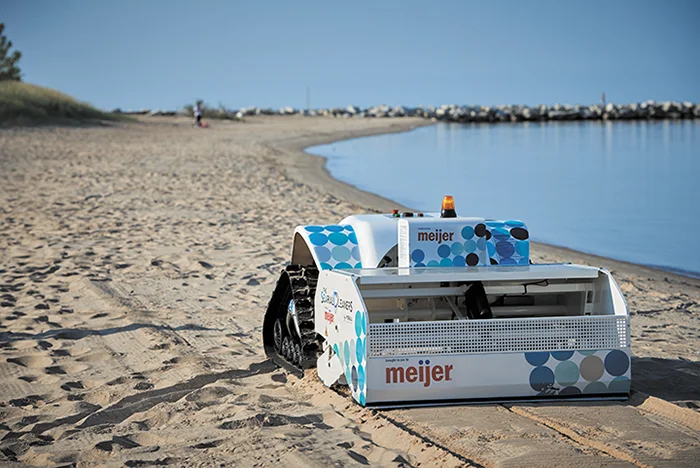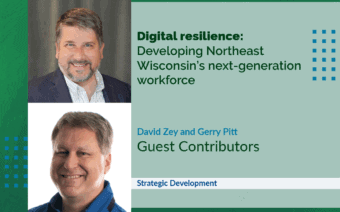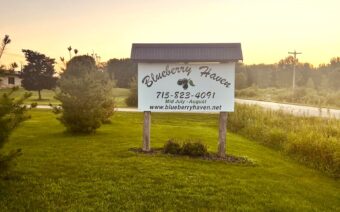
May 5, 2023
NORTHEAST WISCONSIN – In recent years, more and more businesses have been putting more of a focus on sustainability initiatives – both within the organization itself and in the community around them.
Meijer, a supercenter headquartered in?? the Midwest with locations throughout Northeast Wisconsin, is an example of a company doing just that.
Since 2022, Meijer has committed to helping the Great Lakes stewardship.
The company’s most recent initiative included a more than $1.5 million donation to the Council of the Great Lakes Region (CGLR) to bring new technologies – the BeBot and Pixie Drone – to 20 beaches and marinas for pollution clean-up – 10 of those being in Northeast Wisconsin.
Erik Petrovskis, director of environmental compliance and sustainability at Meijer, said the partnership made sense since the superstore is a Great Lakes-based retailer and aligns with the company’s own sustainability initiatives.
“At Meijer, our mission is to enrich lives and the communities we serve – and sustainability is a key part of that mission,” he said. “For our customers, plastic pollution is at the top of their list of issues they think Meijer should work on… That’s how our partnership with the Council for the Great Lakes region came about.”
Identifying the where
When it came to choosing which Great Lakes beaches the initiative would focus on, Petrovskis said Meijer collaborated with the University of Wisconsin-Oshkosh (UWO) to identify which ones needed the most help.
Greg Kleinheinz, director of the Environmental Research and Innovation Center at UWO, said the school has done a lot of work on the Great Lakes related to water quality issues for several decades.
“We have labs on the Great Lakes in Door County, we have a lab in Sturgeon Bay… (and) a lab in Manitowoc,” he said. “We’ve got a couple of projects through NOAA (National Oceanic and Atmospheric Administration) and through the U.S. EPA (Environmental Protection Agency) on marine debris. We’ve been doing beach grooming for 15 years as part of EPA projects.”
Then, a few years ago, Kleinheinz said the CGLR reached out looking to build a network of people and organizations who had expertise with marine debris in the states around the Great Lakes, which he said made the collaboration with Meijer a smooth process.
“We started working on this Meijer project because it dovetailed nicely with our own internal projects,” he said.
Selecting which beaches and marinas to clean was up to Kleinheinz and his UWO students.
“(We chose) high-use areas that, over the years, we have recognized there is debris and things available for cleanup,” he said. “We (also) have a partnership with that local community, and they’re invested in it as well.”
The following beaches and marinas will be cleaned across the state’s northeast region:
Red Arrow Park in ManitowocNeshotah Park in Two RiversBlue Rail Marina Beach in ManitowocMurphy Park in Egg HarborBaileys Harbor Ridges in Baileys HarborManitowoc Marina in ManitowocAlgoma Marina in AlgomaSturgeon Bay in Sturgeon BayAhnapee River in AlgomaKewaunee River Mouth in Kewaunee“Our core mission is still education,” Kleinheinz said. “This is a great way for us to integrate our educational mission with communities.”
The technology
To assist in the beach clean-up project, Meijer has deployed the BeBot and the Pixie Drone – a robot and drone, respectively, that remove plastic pollutants across sandy shores and rippling waves.
//17bec5072710cda5b8dd81b69f4c6e58.cdn.bubble.io/f1683300977667x405645256859007000/richtext_content.webpThe Pixie Drone is a water-borne robot that can collect up to 200 pounds of waste in the water before needing to be emptied out. Photo Courtesy of Meijer
The BeBot, Petrovskis said, is a battery-powered and remote-controlled robot that runs along the beach – covering up to 32,000 square feet and digging about six inches below the surface to sift and shake up sand.
“All of the bits of plastic and trash within that sand can be collected,” he said.
The Pixie Drone, which is also battery-powered and remote-controlled, takes to the water and can collect up to 200 pounds of pollutants during each deployment.
Petrovskis said the machine also tracks the temperature, PH, salinity and other water data while running.
“The machines are new to the Midwest,” he said. “I believe we’re the first retailer to deploy such devices (in this area).”
While the two machines work toward the same goal – cleaner beaches – Kleinheinz said they aren’t always at the same beach on the same day.
“We have what we call our satellite labs, we actually have our students – or what we call field staff – in those counties from a little before Memorial Day through Labor Day,” he said. “Our approach is to take (the robots) to, for example, Manitowoc Marina one day and then (the field staff) will go to Kohler Andrae with the BeBot the next day. So the BeBot and Pixie Drone… will go to different places on the same day. They’re not tied together.”
Business and tourism
The cleaning of the Great Lakes beaches goes beyond a better and healthier environment, Petrovskis said – it also affects business and tourism in the areas in which the clean up is taking place.
“It’s estimated more than 22 million pounds of plastic litter enters the Great Lakes every year,” he said. “It’s important for us to raise awareness for our customers and other beachgoers… We can all reduce our use of plastic and discharging plastic litter to the Great Lakes.”
Barb LaMue, president & CEO of New North, Inc. – a regional economic development nonprofit – echoed Petrovskis’ sentiment.
“New North is proud of Lake Michigan’s western 308 miles of shoreline, along with more than 93 unique parks, trails, camps and nature centers, providing more than 760 miles of hiking and biking access in Northeast Wisconsin,” she said. “It is because of our great outdoor recreational opportunities that visitors flock here on vacation or (residents) spend time in their backyards.”
Removing the pollutants in the water, LaMue said, will also provide other helpful information.
“Besides removing trash, it will also provide data on consumer waste,” she said. “We are thankful for Meijer’s donation to the Council of the Great Lakes Region.”
The importance of sustainability
For those at UWO and throughout the entire University of Wisconsin System, Kleinheinz said it’s “critically important” to be involved in sustainability projects such as this – referencing the Wisconsin Idea, which was coined by Charles Van Hise, the first president of the University of Wisconsin System.
“What it says is the work of the university should extend to the borders of the state and beyond,” he said. “We have a lot of human capital in terms of students who want to be involved in these projects. They want to use hands-on, applied learning outside the classroom to make an impact in their communities.”
//17bec5072710cda5b8dd81b69f4c6e58.cdn.bubble.io/f1683301039376x771864035635361300/richtext_content.webpGreg Kleinheinz
This, Kleinheinz said, makes the Meijer partnership “the ideal situation.”
“We have a corporate partner that has an alignment of values and interests,” he said. “We have students who have bought into what they’re doing, and we have communities that wouldn’t be able to do this otherwise.”
Petrovsksis said, for Meijer, when issues are “important to our customers, they’re important to us.”
“The Great Lakes are an incredible resource,” he said. “They’re critical for our suppliers and farmers. We sell food in our stores, and we need to have a healthy agricultural economy to do that. It’s important to our customers and suppliers.”
The company’s continual push for a healthier environment, he said, directly links to its history.
“Environmental stewardship is part of our company’s DNA,” he said. “Fred Meijer spoke at the very first Earth Day (in Grand Rapids) in 1970. So, these initiatives are important to serve our communities, and also to support our businesses. That’s what sustainability is about – meeting all those needs.”
Kleinheinz said the hope is that the collaboration will cause a domino effect for the future of sustainability throughout Wisconsin.
“We’re hoping this serves as a catalyst that others will say, ‘Hey, this is a great way we can partner and do this in our community,’” he said. “If you think about Northeast Wisconsin, there’s a lot of other communities where one BeBot and one Pixie Drone aren’t going to get the job done for everything. (We can) use this as a template of success and find other willing partners to try and spread the same work to other communities.”
 Prairie Dairy raises heifers for fellow dairymen
Prairie Dairy raises heifers for fellow dairymen How powerful is paper in NE Wisconsin?
How powerful is paper in NE Wisconsin?






